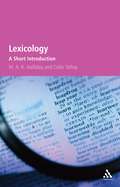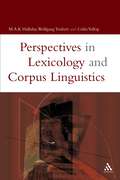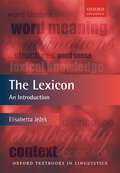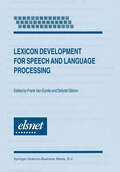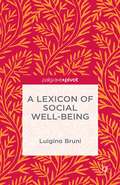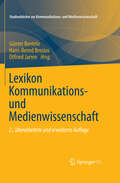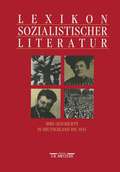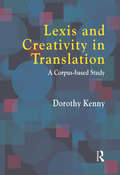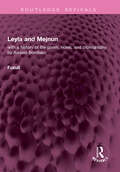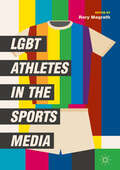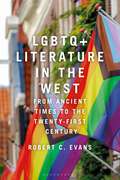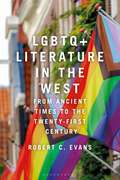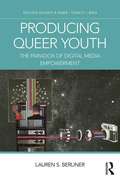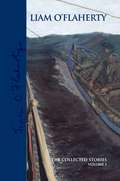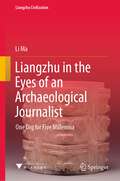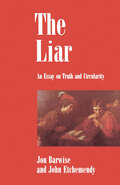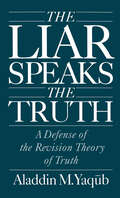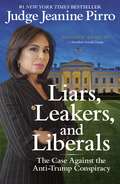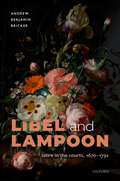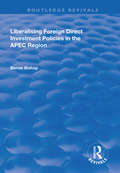- Table View
- List View
Lexicology: A Short Introduction
by M.A.K. Halliday Colin YallopThis readable introductory textbook presents a concise survey of lexicology. The first section of the book is a survey of the study of words, providing students with an overview of basic issues in defining and understanding the word as a unit of language. This section also examines the history of lexicology, the evolution of dictionaries and recent developments in the field. The second section extends this study of lexicology into the relationship between words and meaning, etymology, prescription, language as social phenomenon and translation. Lexicology: A Short Introduction will be of interest to undergraduate students of linguistics.
Lexicology and Corpus Linguistics (Open Linguistics)
by M.A.K. Halliday Anna Cermáková Wolfgang Teubert Colin YallopPerspectives in Lexicology and Corpus Linguistics offers an introduction to words and corpus linguistics. From this foundation it explores the much wider issues that are inevitably raised but somehow marginalized in lexicology (the study of words) and corpus linguistics: how are individual words integrated into language? What are the real benefits of studying the large quantities of text now available in corpora? How do we best conceptualize meaning itself?
The Lexicon: An Introduction (Oxford Textbooks in Linguistics)
by Elisabetta JežekThe Lexicon provides an introduction to the study of words, their main properties, and how we use them to create meaning. It offers a detailed description of the organizing principles of the lexicon, and of the categories used to classify a wide range of lexical phenomena, including polysemy, meaning variation in composition, and the interplay with ontology, syntax, and pragmatics. Elisabetta Ježek uses empirical data from digitalized corpora and speakers' judgements, combined with the formalisms developed in the field of general and theoretical linguistics, to propose representations for each of these phenomena. The key feature of the book is that it merges theoretical accounts with lexicographic approaches and computational insights. Its clear structure and accessible approach make The Lexicon an ideal textbook for all students of linguistics—theoretical, applied, and computational—and a valuable resource for scholars and students of language in the fields of cognitive science and philosophy.
Lexicon Development for Speech and Language Processing (Text, Speech and Language Technology)
by Frank Van EyndeA Lexicon of Social Well-Being
by Luigino Bruni NA NAWe must quickly learn how to live well in the world as it is today, including the realm of work. We need to learn a new vocabulary of economics and markets that is more suitable to understand the present world and that is likely to offer us the tools to act, and perhaps improve it as well.
Lexikon Kommunikations- und Medienwissenschaft (Studienbücher zur Kommunikations- und Medienwissenschaft)
by Günter Bentele Hans-Bernd Brosius Otfried Jarrenliegt noch nicht vor
Lexis and Creativity in Translation: A Corpus Based Approach
by Dorothy KennyComputers offer new perspectives in the study of language, allowing us to see phenomena that previously remained obscure because of the limitations of our vantage points. It is not uncommon for computers to be likened to the telescope, or microscope, in this respect. In this pioneering computer-assisted study of translation, Dorothy Kenny suggests another image, that of the kaleidoscope: playful changes of perspective using corpus-processing software allow textual patterns to come into focus and then recede again as others take their place. And against the background of repeated patterns in a corpus, creative uses of language gain a particular prominence. In Lexis and Creativity in Translation, Kenny monitors the translation of creative source-text word forms and collocations uncovered in a specially constructed German-English parallel corpus of literary texts. Using an abundance of examples, she reveals evidence of both normalization and ingenious creativity in translation. Her discussion of lexical creativity draws on insights from traditional morphology, structural semantics and, most notably, neo-Firthian corpus linguistics, suggesting that rumours of the demise of linguistics in translation studies are greatly exaggerated. Lexis and Creativity in Translation is essential reading for anyone interested in corpus linguistics and its impact so far on translation studies. The book also offers theoretical and practical guidance for researchers who wish to conduct their own corpus-based investigations of translation. No previous knowledge of German, corpus linguistics or computing is assumed.
Lexis and Creativity in Translation: A Corpus Based Approach
by Dorothy KennyComputers offer new perspectives in the study of language, allowing us to see phenomena that previously remained obscure because of the limitations of our vantage points. It is not uncommon for computers to be likened to the telescope, or microscope, in this respect. In this pioneering computer-assisted study of translation, Dorothy Kenny suggests another image, that of the kaleidoscope: playful changes of perspective using corpus-processing software allow textual patterns to come into focus and then recede again as others take their place. And against the background of repeated patterns in a corpus, creative uses of language gain a particular prominence. In Lexis and Creativity in Translation, Kenny monitors the translation of creative source-text word forms and collocations uncovered in a specially constructed German-English parallel corpus of literary texts. Using an abundance of examples, she reveals evidence of both normalization and ingenious creativity in translation. Her discussion of lexical creativity draws on insights from traditional morphology, structural semantics and, most notably, neo-Firthian corpus linguistics, suggesting that rumours of the demise of linguistics in translation studies are greatly exaggerated. Lexis and Creativity in Translation is essential reading for anyone interested in corpus linguistics and its impact so far on translation studies. The book also offers theoretical and practical guidance for researchers who wish to conduct their own corpus-based investigations of translation. No previous knowledge of German, corpus linguistics or computing is assumed.
Leyla and Mejnun: with a history of the poem, notes, and bibliography by Alessio Bombaci (Routledge Revivals)
by FuzuliFirst published in 1970, Leyla and Mejnun provides a thorough introduction to the Leyla and Mejnun love story and the various forms in which the story has appeared in the Islamic world. Finally, it offers for the delight of the English poetry lover, an extremely readable translation of the Turkish version of the story. This book will be of interest to students of literature and history.
Leyla and Mejnun: with a history of the poem, notes, and bibliography by Alessio Bombaci (Routledge Revivals)
by FuzuliFirst published in 1970, Leyla and Mejnun provides a thorough introduction to the Leyla and Mejnun love story and the various forms in which the story has appeared in the Islamic world. Finally, it offers for the delight of the English poetry lover, an extremely readable translation of the Turkish version of the story. This book will be of interest to students of literature and history.
LGBT Athletes in the Sports Media
by Rory MagrathIn recent years, lesbian, gay, bisexual, and transgender (LGBT) athletes have received more media attention than ever before. Declining levels of homophobia across the Western world has facilitated a greater acceptance of LGBT athletes among heterosexual teammates, fans, and the sports media. Consequently, academic interest in sport, gender and sexuality has also increased substantially. This edited collection combines studies of gender and sexuality with that of the sports media to provide the first-ever comprehensive academic overview of LGBT athletes in the sports media. It draws upon work from a wide range of international scholars to provide an interdisciplinary analysis of improved media coverage of LGBT athletes, as well as the numerous issues and barriers which continue to exist. LGBT Athletes in the Sports Media will be of interest to students and scholars across a range of disciplines, including sociology, media studies, and gender studies.
LGBTQ+ Literature in the West: From Ancient Times to the Twenty-First Century
by Robert C. EvansA survey, within one volume, of the history of critical responses to LGBTQ literature from the beginning to the present day, this book explores changes in attitudes, literature and criticism over a period of two and a half thousand years. For various reasons it focuses on literature of 'the West', trying to give readers a clear sense, within a relatively short compass, not only of the development of 'queer' literature (perhaps the most encompassing of all terms) but especially of critical responses to that literature, notably during the past century and particularly the past fifty years.All in all, this book offers a roadmap to much of the excellent scholarship concerning LGBTQ literature that has arisen in the last half-century – an era of unparalleled interest in the topic and an era that has moved the topic from the distant sidelines of literary study to a place ever closer to the center of things.
LGBTQ+ Literature in the West: From Ancient Times to the Twenty-First Century
by Robert C. EvansA survey, within one volume, of the history of critical responses to LGBTQ literature from the beginning to the present day, this book explores changes in attitudes, literature and criticism over a period of two and a half thousand years. For various reasons it focuses on literature of 'the West', trying to give readers a clear sense, within a relatively short compass, not only of the development of 'queer' literature (perhaps the most encompassing of all terms) but especially of critical responses to that literature, notably during the past century and particularly the past fifty years.All in all, this book offers a roadmap to much of the excellent scholarship concerning LGBTQ literature that has arisen in the last half-century – an era of unparalleled interest in the topic and an era that has moved the topic from the distant sidelines of literary study to a place ever closer to the center of things.
Lgbtq Youth And The Paradox Of Digital Media Empowerment (Routledge Research In Gender, Sexuality, And Media Series (PDF).)
by Lauren S. BerlinerProducing Queer Youth challenges popular ideas about online media culture as a platform for empowerment, cultural transformation, and social progress. Based on over three years of participant action research with queer teen media-makers and textual analysis of hundreds of youth-produced videos and popular media campaigns, the book unsettles assumptions that having a "voice" and gaining visibility and recognition necessarily equate to securing rights and resources. Instead, Berliner offers a nuanced picture of openings that emerge for youth media producers as they negotiate the structures of funding and publicity and manage their identities with digital self-representations. Examining youth media practices within broader communication history and critical media pedagogy, she forwards an approach to media production that re-centers the process of making as the site of potential learning and social connection. Ultimately, she reframes digital media participation as a struggle for―rather than, in itself, evidence of―power.
Lgbtq Youth And The Paradox Of Digital Media Empowerment: (Routledge Research in Gender, Sexuality, and Media)
by Lauren S. BerlinerProducing Queer Youth challenges popular ideas about online media culture as a platform for empowerment, cultural transformation, and social progress. Based on over three years of participant action research with queer teen media-makers and textual analysis of hundreds of youth-produced videos and popular media campaigns, the book unsettles assumptions that having a "voice" and gaining visibility and recognition necessarily equate to securing rights and resources. Instead, Berliner offers a nuanced picture of openings that emerge for youth media producers as they negotiate the structures of funding and publicity and manage their identities with digital self-representations. Examining youth media practices within broader communication history and critical media pedagogy, she forwards an approach to media production that re-centers the process of making as the site of potential learning and social connection. Ultimately, she reframes digital media participation as a struggle for―rather than, in itself, evidence of―power.
Liam O'Flaherty: the Collected Stories, Volume 1
by NA NAThese long-awaited volumes bring together, for the first time ever, the complete short stories of Ireland's master storyteller, Liam O'Flaherty - from great classics like "The Sniper" to previously unpublished originals. These 182 stories include all those included in previous anthologies; the Irish language stories; stories which have never before been collected inn book form; and original stories published here for the first time. This luxurious set will be a treasure for all those who know and love the work of one of Ireland's most skilled and passionate writers.
Liangzhu in the Eyes of an Archaeological Journalist: One Dig for Five Millennia (Liangzhu Civilization)
by Li MaThis book traces archaeological exploration and discoveries as early as 2012 and reveals Liangzhu culture by reviewing seven years of archaeological findings at the Liangzhu historical site, developments in archaeology history, the psychological journeys of archaeologists, as well as the collision of schools of thought. It also contains in-depth interviews with archaeological experts and other specialists, building a bridge between popular interest and academic interest, and showcases Liangzhu civilization and archaeology for professionals and the general public alike.
The Liar: An Essay on Truth and Circularity
by Jon Barwise John EtchemendyBringing together powerful new tools from set theory and the philosophy of language, this book proposes a solution to one of the few unresolved paradoxes from antiquity, the Paradox of the Liar. Treating truth as a property of propositions, not sentences, the authors model two distinct conceptions of propositions: one based on the standard notion used by Bertrand Russell, among others, and the other based on J.L. Austin's work on truth. Comparing these two accounts, the authors show that while the Russellian conception of the relation between sentences, propositions, and truth is crucially flawed in limiting cases, the Austinian perspective has fruitful applications to the analysis of semantic paradox. In the course of their study of a language admitting circular reference and containing its own truth predicate, Barwise and Etchemendy also develop a wide range of model-theoretic techniques--based on a new set-theoretic tool, Peter Aczel's theory of hypersets--that open up new avenues in logical and formal semantics.
The Liar Speaks the Truth: A Defense of the Revision Theory of Truth
by Aladdin M. YaqubIn this book, Yaqūb describes a simple conception of truth and shows that it yields a semantical theory that accommodates the whole range of our seemingly conflicting intuitions about truth. This conception takes the Tarskian biconditionals (such as "The sentence 'Johannes loved Clara' is true if and only if Johannes loved Clara") as correctly and completely defining the notion of truth. The semantical theory, which is called the revision theory, that emerges from this conception paints a metaphysical picture of truth as a property whose applicability is given by a revision process rather than by a fixed extension. The main advantage of this revision process is its ability to explain why truth seems in many cases almost redundant, in others substantial, and yet in others paradoxical (as in the famous Liar). Yaqūb offers a comprehensive defense of the revision theory of truth by developing consistent and adequate formal semantics for languages in which all sorts of problematic sentences (Liar and company) can be constructed. Yaqūb concludes by introducing a logic of truth that further demonstrates the adequacy of the revision theory.
Liars, Leakers, and Liberals: The Case Against The Anti-trump Conspiracy
by Judge Jeanine PirroAs an online commentator and host of her own show on Fox for many years, Judge Jeanine Pirro has seen firsthand how narratives take form, whether they are based in truth or not. In her explosive new book, she will write about some of the most egregious lies she's seen, and also interview various people who have been affected by fake news stories. Judge Jeanine will begin at her home base, Fox, and discuss her own experiences. Judge Jeanine believes that many modern-day feminists are promoting the lie that women have been oppressed by men since the beginning of time. She'll talk about Hillary Clinton, and the lie that if you didn't support her, you are a woman hater. Judge Jeanine will interview Ivanka Trump about this, and mention the different ways mainstream press talks about conservative women vs liberals. No topic is off limits in LIARS, LEAKERS, AND LIBERALS. Judge Jeanine will take on: * Antifa * Black Lives Matter and the media lie that set off race riots around the country * Obama - The reality of what Trump inherited regarding foreign and domestic messes * Trump - How the media has twisted his words to fit the narrative they've created, including firsthand accounts from people like Eric Trump and Corey Lewandowski * Anonymous sources and what can be done to curb the damage they doLeakers in the White House - why it really is a big deal, examples through history of leakers * Safe Spaces - The world is not safe. If you're old enough to go to war, you're old enough to hear an opinion you don't like. LIARS, LEAKERS, AND LIBERALS is Judge Jeanine's no-holds-barred answer to fake news, and it promises to be an enlightening and provocative read!
Libel and Lampoon: Satire in the Courts, 1670-1792 (Law and Literature)
by Andrew Benjamin BrickerLibel and Lampoon shows how English satire and the law mutually shaped each other during the long eighteenth century. Following the lapse of prepublication licensing in 1695, the authorities quickly turned to the courts and newly repurposed libel laws in an attempt to regulate the press. In response, satirists and their booksellers devised a range of evasions. Writers increasingly capitalized on forms of verbal ambiguity, including irony, allegory, circumlocution, and indirection, while shifty printers and booksellers turned to a host of publication ruses that complicated the mechanics of both detection and prosecution. In effect, the elegant insults, comical periphrases, and booksellers' tricks that came to typify eighteenth-century satire were a way of writing and publishing born of legal necessity. Early on, these emergent satiric practices stymied the authorities and the courts. But they also led to new legislation and innovative courtroom procedures that targeted satire's most routine evasions. Especially important were a series of rulings that increased the legal liabilities of printers and booksellers and that expanded and refined doctrines for the courtroom interpretation of verbal ambiguity, irony, and allegory. By the mid-eighteenth century, satirists and their booksellers faced a range of newfound legal pressures. Rather than disappearing, however, personal and political satire began to migrate to dramatic mimicry and caricature-acoustic and visual forms that relied less on verbal ambiguity and were therefore not subject to either the provisions of preperformance dramatic licensing or the courtroom interpretive procedures that had earlier enabled the prosecution of printed satire.
Libel and Lampoon: Satire in the Courts, 1670-1792 (Law and Literature)
by Andrew Benjamin BrickerLibel and Lampoon shows how English satire and the law mutually shaped each other during the long eighteenth century. Following the lapse of prepublication licensing in 1695, the authorities quickly turned to the courts and newly repurposed libel laws in an attempt to regulate the press. In response, satirists and their booksellers devised a range of evasions. Writers increasingly capitalized on forms of verbal ambiguity, including irony, allegory, circumlocution, and indirection, while shifty printers and booksellers turned to a host of publication ruses that complicated the mechanics of both detection and prosecution. In effect, the elegant insults, comical periphrases, and booksellers' tricks that came to typify eighteenth-century satire were a way of writing and publishing born of legal necessity. Early on, these emergent satiric practices stymied the authorities and the courts. But they also led to new legislation and innovative courtroom procedures that targeted satire's most routine evasions. Especially important were a series of rulings that increased the legal liabilities of printers and booksellers and that expanded and refined doctrines for the courtroom interpretation of verbal ambiguity, irony, and allegory. By the mid-eighteenth century, satirists and their booksellers faced a range of newfound legal pressures. Rather than disappearing, however, personal and political satire began to migrate to dramatic mimicry and caricature-acoustic and visual forms that relied less on verbal ambiguity and were therefore not subject to either the provisions of preperformance dramatic licensing or the courtroom interpretive procedures that had earlier enabled the prosecution of printed satire.
Liberalising Foreign Direct Investment Policies in the APEC Region
by Bernie BishopThis title was first published in 2001. This work is a response to criticisms that investment liberalization in the APEC region is not moving quickly enough. It commences with a historical overview of APEC's process for investment liberalization and a description of current foreign direct investment policies for each of the APEC economies. It then argues that there are significant constraints to further liberalization arising from economic development concerns in the developing countries and political considerations in both developed and developing countries in the region. It also suggests that a truly liberalized investment environment would involve the removal of investment incentives. Again, there are political and institutional reasons that make this difficult. With several suggestions for further research that should better inform policy makers, this is an informative insight into the complex issues involved in the liberalization process in the APEC region.
Liberalising Foreign Direct Investment Policies in the APEC Region
by Bernie BishopThis title was first published in 2001. This work is a response to criticisms that investment liberalization in the APEC region is not moving quickly enough. It commences with a historical overview of APEC's process for investment liberalization and a description of current foreign direct investment policies for each of the APEC economies. It then argues that there are significant constraints to further liberalization arising from economic development concerns in the developing countries and political considerations in both developed and developing countries in the region. It also suggests that a truly liberalized investment environment would involve the removal of investment incentives. Again, there are political and institutional reasons that make this difficult. With several suggestions for further research that should better inform policy makers, this is an informative insight into the complex issues involved in the liberalization process in the APEC region.
